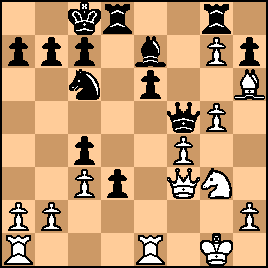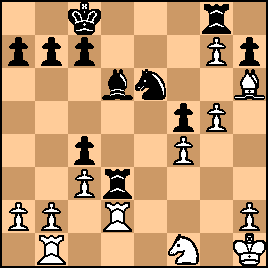| Apr-08-04 | | capanegra: This game represented an important improve for the Max Lange theory. Here Marshall introduced the move 15.♗h6! for the first time, which happens to be very strong, because it turns the white Pawns on the King side into a very dangerous weapon. However, 16…♗d6 wasn’t the best reply. Better is 16…♗e7, or even 16…♙d2, with a very complicated game in both lines. |
|
| Apr-09-04 | | Calli: Marshall and Capablanca played some training games to test out the variation. I guess Marshall knew he had something when Capa couldn't beat him. See http://www.chessgames.com/perl/ches... |
|
| Apr-09-04 | | Lawrence: <capanegra>, Junior doesn't see that 16...Be7 can be better than 16...Bd6. It says that the latter and 16...Rd7 and 16...d2 all give equality whereas 16...Be7 17.Qf3 is +0.56 favourable to Whites. (10 min. search) |
|
| Apr-09-04 | | capanegra: <Calli> Interesting! I didn’t know that Capa and Marshall had tested this variation. However, the game with Tarrasch would still be the first experiment with 15.♗h6 because –according to the database- it was played in July 1910, while the games with JRC were played in October 1910. <Lawrence> Looking at Calli’s games –and with the mighty Capablanca playing Black- it seems that you have a good point with the suspicious 16…♗e7. I had only taken for granted the continuation 17.♕f3 ♕d5 18.♕f7 (which happens to be the only draw out of the three games in the database). But 18.♕f4 seems to be quite stronger. It is a pity that there are no more games in the database with this continuation. Nevertheless, the statistics seem to be conclusive: after 15.♗h6, 64% of the games are won by White, 29% are drawn, and Black wins 7% (one single game out of fourteen). So, is this signifying the end of the Max Lange attack? |
|
| Apr-09-04 | | Lawrence: <capanegra>, after 17.♕f3 ♕d5 Junior suggests 18.b3 ♘e5 eval +0.37 (45 min. search) |
|
| Apr-28-07 | | gambitfan: GTM 42
PAR 39
9 times |
|
| Oct-22-09 | | Max Lange: I like this game since usually Tarrasch is shown beating poor Marshall. Payback! |
|
Dec-21-10
 | | GrahamClayton: <Calli>Marshall and Capablanca played some training games to test out the variation. <Calli>,
Here is an interesting report from the "El Paso Herald", dated 8 April, 1911, which mentions that some more analysis had been done on the Max Lange Attack prior to this game: "Shortly before the date of the tournament various chess players of renown had been exercising their critical faculties on the familiar Max
Lange opening. Three distinguished foreign masters, after an exhaustive
analysis, had evolved a defence which they contended completely broke up
the attack. As a practical test of the analysis, a series of games at this
opening was played in London between Blackburne, Gunsberg and other experts, and in each game the attack failed badly. The Max Lange had been
proved an imposter, and was promptly relegated to the limbo of exploded
fallacies. The Hamburg tournament arrived, and in the first round Marshall played the discredited Max Lange against Tarrasch, the master of research. As a suicidal proceeding this seemed on a par with bowling full
pitches to Victor Trumper or leaving the red ball over the middle pocket
for George Gray. But Marshall, who is a player of the Morphy school, knew
what he was about. Initiative and audacity beat caution and research and
Dr. Tarrasch lost the game." |
|
| Apr-10-14 | | Karpova: According to the 'ACB', shortly before departing for Europe, Marshall had examined the Scottish Gambit and especially the Max Lange Attack. He arrived at important insights during several sessions with experts from the city, especially with Captain <B. T. Walling>. Captain Walling, after travelling to St. Juan in Puerto Rico was, of cource, enlightened when he heard that Marshall had beat Tarrasch with this plan. Source: 'Wiener Schachzeitung', October-November 1910, pp. 369-370 |
|
| Apr-10-14 | | Benzol: <Graham> See <Karpova>'s comments and mine ( 10th August 2004 ) on the Capablanca vs Marshall, 1925 game for a bit more background on Marshall's researches into this line. |
|
| Jul-25-17 | | sudoplatov: In tournament play, Marshall holds the edge of 6-5 (losing the first 4 decisive gains). Tarrasch won the match 8-1. |
|
| Jul-25-17 | | JimNorCal: As I recall, Ed Lasker's Chess Secrets has a story about this game. I think EL was playing in the minor tournament. He listened to Marshall's post mortem and resolved to play the same novelty. However, the opponent played a move that Marshall had said was better than Tarrasch's response. Lasker was kicking himself for not asking how to counter the better move. I don't recall how the game ended. |
|
| Jul-25-17 | | JimNorCal: Here's the Ed Lasker game.
Ed. Lasker vs Rotlewi, 1910 |
|
Aug-02-19
 | | Sally Simpson: ***
Marshall vs Tarrasch, 1910 (kibitz #8) From the "El Paso Herald", dated 8 April, 1911. "The Max Lange had been proved an imposter, and was promptly relegated to the limbo of exploded fallacies." They just don't write like that anymore. It inspired this. https://www.redhotpawn.com/imgu/blo... *** |
|
Aug-02-19
 | | perfidious: That report from El Paso is delicious. |
|
Aug-02-19
 | | Sally Simpson: ***
The link has failed. This works.
https://www.redhotpawn.com/imgu/blo... *** |
|
| Oct-16-23 | | Gaito: 
click for larger viewBLACK TO MOVE
In the diagrammed position Dr. Tarrasch played 16...Bd6 in this game. Three months later (in New York, on October 17, 1910) Capablanca tried 16...Be7 against Marshall, and the latter won too. See game in this link: Marshall vs Capablanca, 1910 |
|
| Oct-16-23 | | Gaito: 
click for larger viewBLACK TO MOVE
According to engine Komodo 13 this was a critical moment of the game. Dr. Tarrasch played 20...Qf7?!, a move to which the engine assigns an evaluation of +1.19. Suggested is 20...Qb5 21.Rab1 d2 22.Red1 Rd3 23.Qe4 Nd8 24.Kh1 Bd6 25.Nf1 Qf5 26.Qxf5 exf5 27.Rxd2 Ne6 with an evaluation of +0.62 (almost level). See diagram below:

click for larger view |
|
Oct-17-23
 | | NM JRousselle: Marshall contributed an amazing amount of opening theory. His 15 Bh6! in this game is but one example. Of course, there is the Marshall Gambit in the Ruy Lopez. His Bb4+ in the then main line of the 2 knights defense (see his game vs Salwe) revived this opening. He also discovered Qa4+ in a line of the King's Gambit declined, reviving that opening as well. |
|





